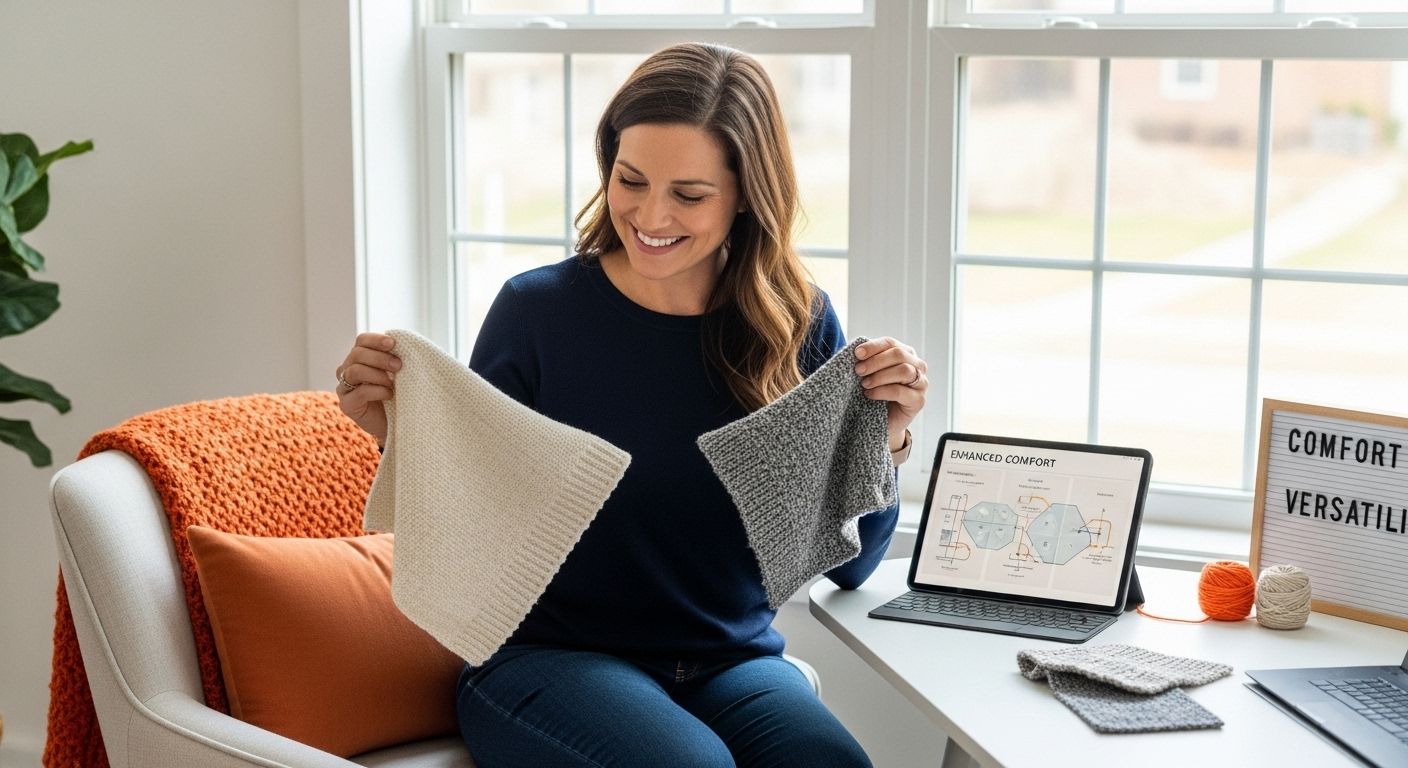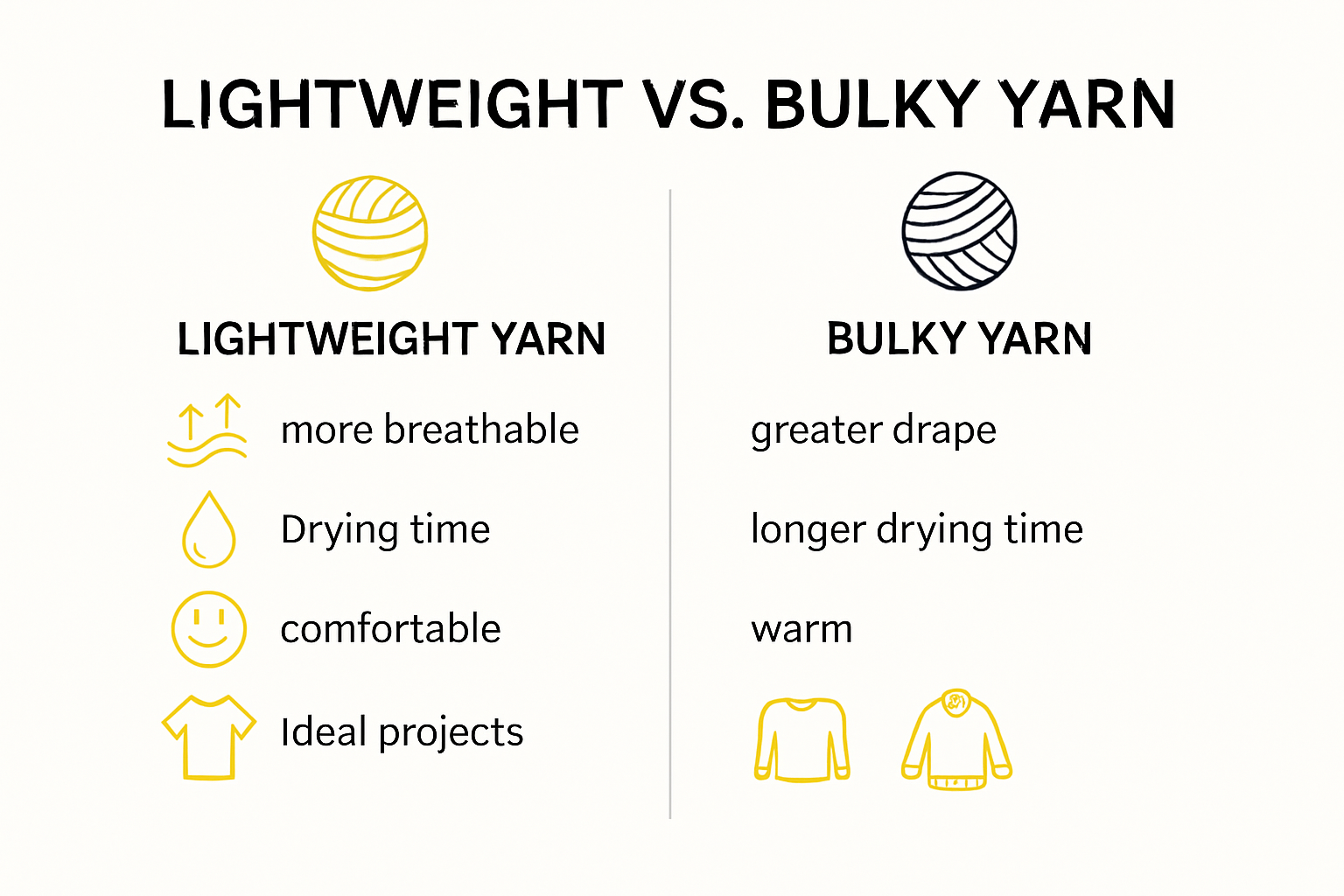
Why Use Lightweight Yarn: Understanding Its Benefits
Lightweight yarn is changing what crafters can make. Some lightweight yarns show superior breathability and can even speed up drying time compared to standard threads. Most people expect delicate yarn to be fragile and hard to handle. Actually, modern lightweight yarns bring surprising strength and even outlast bulkier options in durability tests.

Table of Contents
- What Is Lightweight Yarn And Its Characteristics?
- The Benefits Of Choosing Lightweight Yarn For Your Projects
- How Lightweight Yarn Affects The Final Outcome Of Your Work
- Key Concepts In Using Lightweight Yarn Effectively
Quick Summary
| Takeaway | Explanation |
|---|---|
| Choose lightweight yarn for comfort. | Lightweight yarns provide exceptional breathability and reduced fabric weight, making garments more comfortable. |
| Master tension for best results. | Precise tension control is essential to keep the delicate nature of lightweight yarn intact during crafting. |
| Plan your project meticulously. | Detailed project schematics and careful preparation help address the unique challenges of working with fine threads. |
| Explore creative applications widely. | Lightweight yarns allow for intricate patterns and designs across various crafting projects, enhancing versatility. |
| Understand material compatibility. | Pairing lightweight yarn with suitable complementary materials is crucial for optimal crafting success and durability. |
What is Lightweight Yarn and Its Characteristics?
Lightweight yarn represents a specialized textile material characterized by minimal weight and exceptional versatility in crafting applications. Unlike traditional heavy yarns, lightweight yarns offer crafters unique advantages in creating delicate, breathable, and comfortable textile projects.
Defining Lightweight Yarn
Lightweight yarn is technically defined by its low linear density and minimal mass per unit length. According to research from the National Center for Biotechnology Information, these yarns are characterized by specific structural properties that differentiate them from standard textile threads:
- Reduced mass per unit volume
- Lower thread count and thickness
- Enhanced flexibility and drape
- Minimal fiber density
These characteristics make lightweight yarns particularly suitable for creating garments, accessories, and decorative items that require minimal bulk and maximum comfort.
To help you quickly understand how lightweight yarn compares to standard and heavier yarns, the table below highlights the distinct features and typical uses of each yarn weight category.
| Yarn Weight Category | Key Characteristics | Typical Applications |
|---|---|---|
| Lightweight Yarn | Minimal mass, high breathability, flexible | Summer garments, shawls, intricate items |
| Standard/Medium Yarn | Moderate thickness, balanced drape | Sweaters, scarves, hats |
| Heavier/Bulky Yarn | Thick, high warmth, substantial weight | Blankets, chunky sweaters, winter wear |
Structural Characteristics and Performance
The structural composition of lightweight yarn involves intricate manufacturing processes that optimize its performance. Yarn weight is typically measured using metrics like WPI (Wraps Per Inch) and linear density, which determine its overall characteristics. Research indicates that lightweight yarns often undergo specialized spinning techniques to achieve their unique properties.
For crafters interested in exploring different yarn weights, our comprehensive guide on yarn types provides additional insights into understanding various yarn characteristics.
Key performance attributes of lightweight yarn include:
- Superior breathability
- Reduced thermal retention
- Enhanced drape and movement
- Quick-drying capabilities
- Minimal fabric weight
These qualities make lightweight yarn an excellent choice for creating summer garments, delicate shawls, lightweight sweaters, and intricate accessories that require finesse and minimal material weight.
The Benefits of Choosing Lightweight Yarn for Your Projects
Lightweight yarn offers crafters a range of advantages that transform traditional textile creation, providing unprecedented versatility and performance across multiple project types. Understanding these benefits can help artisans make more informed decisions about yarn selection and project design.
Enhanced Comfort and Wearability
The primary advantage of lightweight yarn lies in its exceptional comfort characteristics. Research from Materials journal demonstrates that fabrics created with lightweight yarns exhibit superior air permeability and reduced thermal resistance. This translates to tangible benefits for crafters:
- Improved breathability in garments
- Reduced fabric weight and increased mobility
- Better temperature regulation
- Minimal skin irritation
These qualities make lightweight yarn ideal for creating summer clothing, delicate accessories, and garments requiring exceptional drape and movement.
Versatility in Creative Applications
Lightweight yarns unlock creative possibilities across multiple craft domains. Whether designing intricate shawls, elegant summer tops, or lightweight sweaters, these yarns provide unparalleled flexibility. Our guide to sport weight yarn offers additional insights into yarn selection strategies.
Key creative advantages include:
- Enhanced stitch definition
- Greater project flexibility
- Easier manipulation during crafting
- Ability to create complex, delicate patterns
Long-Term Performance and Durability
Contrary to assumptions about lightweight materials, these yarns demonstrate remarkable durability. Studies reveal that carefully manufactured lightweight yarns maintain structural integrity through multiple wash cycles. Sustainable textile production increasingly relies on lightweight yarn technologies that balance performance with resource efficiency.
By selecting lightweight yarn, crafters invest in projects that combine aesthetic elegance with practical performance, creating textiles that are both beautiful and resilient.

How Lightweight Yarn Affects the Final Outcome of Your Work
The selection of lightweight yarn profoundly influences the aesthetic, functional, and tactile qualities of crafted projects. Understanding how these delicate threads transform your creative vision is crucial for achieving exceptional results across various crafting disciplines.
Aesthetic and Structural Impact
Lightweight yarns dramatically alter the visual and structural characteristics of finished projects. According to research from Michigan State University Libraries, the choice of yarn weight directly impacts the project’s overall appearance and feel.
Key aesthetic transformations include:
- Enhanced drape and fluidity
- More intricate and delicate stitch patterns
- Increased translucency and subtle texture
- Reduced visual bulk and weight
These qualities make lightweight yarns particularly effective for creating elegant, sophisticated garments and accessories that require nuanced design elements.
Performance and Functional Characteristics
Beyond visual appeal, lightweight yarn significantly influences a project’s functional performance. Our comprehensive guide to fingering weight yarn explores how yarn weight impacts project functionality.
Performance considerations encompass:
- Superior breathability
- Faster drying times
- Enhanced flexibility
- Reduced thermal resistance
Crafting Complexity and Technical Considerations
The use of lightweight yarn introduces unique technical challenges and opportunities for crafters. Precise tension control becomes paramount when working with these delicate threads. Crafters must develop refined techniques to maintain consistent stitch quality and prevent distortion.
Additionally, lightweight yarns require specialized tools and techniques. Smaller needles, more delicate handling, and increased attention to detail are essential for successfully transforming these fine threads into beautiful, intricate projects.
By understanding and mastering the nuanced characteristics of lightweight yarn, crafters can elevate their work from simple handmade items to sophisticated, professional-quality textiles.
Key Concepts in Using Lightweight Yarn Effectively
Mastering lightweight yarn requires a nuanced understanding of its unique properties and specialized handling techniques. Crafters must develop specific skills and knowledge to maximize the potential of these delicate textile threads.
Tension and Technique Management
Precise tension control is the cornerstone of successful lightweight yarn projects. According to research from the Science Learning Hub, advanced textile technologies have revolutionized yarn production, demanding equally sophisticated crafting techniques.
Critical tension management strategies include:
- Maintaining consistently gentle hand pressure
- Using smaller, more precise needles
- Practicing controlled, even stitching
- Regularly checking project tension
These techniques prevent distortion and ensure the yarn’s inherent delicacy is preserved throughout the crafting process.
Below is a summary table outlining the main technical considerations and skills needed for effectively working with lightweight yarn, providing a scannable reference for crafters eager to master this delicate medium.
| Key Concept | Practical Guidance |
|---|---|
| Tension Control | Maintain gentle, consistent pressure; use appropriate needles |
| Technique Refinement | Practice even stitching and delicate handling |
| Material Compatibility | Match needle size, fiber content, and blocking materials |
| Project Planning | Develop detailed schematics and preparation before starting |
| Advanced Handling | Use stitch markers, careful blocking, and patience with fine details |

Material Selection and Compatibility
Selecting appropriate complementary materials is crucial when working with lightweight yarn. Explore our comprehensive guide to sport weight yarn for deeper insights into yarn compatibility.
Key material considerations involve:
- Matching needle sizes to yarn thickness
- Selecting compatible blocking materials
- Understanding fiber composition
- Choosing appropriate supplementary threads
Advanced Handling and Project Planning
Successful lightweight yarn projects demand meticulous planning and specialized handling techniques. Preparation is paramount. Crafters must anticipate the unique challenges presented by these fine threads, developing strategies that respect the yarn’s delicate nature.
Essential advanced handling techniques include:
- Creating detailed project schematics
- Implementing careful blocking methods
- Using stitch markers for complex patterns
- Practicing patience during intricate sections
By embracing these sophisticated approaches, crafters can transform lightweight yarn from a challenging medium into a powerful tool for creating exquisite, professional-quality textiles.
Experience the True Benefits of Lightweight Yarn with CRAFTISS
Feeling overwhelmed by bulky projects or struggling to achieve the delicate drape highlighted in this article? Choosing the right lightweight yarn can make all the difference. At CRAFTISS Yarn Collection, you can explore a wide range of yarn weights that bring together breathability, comfort, and elegance for your next project.

Ready to transform what you have learned into real results? Visit our main site or browse the Yarn Collection to experience firsthand how quality lightweight yarn can elevate your creations. Enjoy superior stitch definition, comfort, and versatility with every purchase. stock up on premium yarns today and see your ideas come to life.
Frequently Asked Questions
What are the main characteristics of lightweight yarn?
Lightweight yarn is characterized by reduced mass per unit volume, lower thread count and thickness, enhanced flexibility and drape, and minimal fiber density, making it ideal for delicate and breathable textile projects.
How does lightweight yarn affect the comfort of garments?
Lightweight yarn significantly enhances comfort by providing improved breathability, reduced weight, better temperature regulation, and minimal skin irritation, making it suitable for summer clothing and delicate accessories.
Why should I choose lightweight yarn for my crafting projects?
Choosing lightweight yarn allows for greater stitch definition, project flexibility, and the ability to create intricate designs. It also ensures that your finished items remain lightweight and comfortable to wear.
What technical considerations should I keep in mind when using lightweight yarn?
When working with lightweight yarn, it’s crucial to maintain precise tension control, use appropriate needle sizes, and develop advanced handling techniques to ensure quality results and preserve the yarn’s delicate nature.
Recommended
-
[ What is dk weight yarn
– CRAFTISS -
[ Understanding Sport Weight Yarn: A guide for knitters and crocheters
– CRAFTISS](https://craftiss.com/blogs/news/understanding-sport-weight-yarn-a-guide-for-knitters-and-crocheters)
-
[ What is fingering weight yarn? A complete guide to this versatile yarn
– CRAFTISS -
[ Blog
– CRAFTISS


